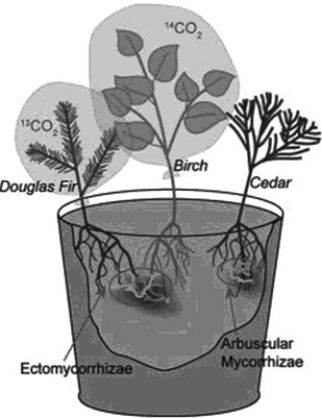Use the following information to answer the question.
Suzanne Simard and colleagues knew that the same mycorrhizal fungal species could colonize multiple types of trees. They wondered if the same fungal individual would colonize different trees, forming an underground network that potentially could transport carbon and nutrients from one tree to another (S. Simard et al. 1997. Net transfer of carbon between mycorrhizal tree species in the field. Nature 388:579-82) .
Pots containing seedlings of three different tree species were set up and grown under natural conditions for three years (Fig.A) . Two of the three species (Douglas fir, birch) could form ectomycorrhizal connections with the same fungal species, but the third species (cedar) could not form an ectomycorrhizal connection with the fungal species. In some of the pots, the researchers placed airtight bags over the Douglas fir and birch seedlings and injected carbon dioxide made from carbon-13 into the bags with the Douglas fir and carbon dioxide made from carbon-14 into the bags with the birch. (¹³C and ¹⁴C are different isotopes of carbon that can be detected and measured by researchers.) As the seedlings photosynthesized, the carbon dioxide was converted into sugars that could be tracked and measured by the researchers. The researchers measured whether the sugars in each plant contained only the carbon isotope that was in the air of their plastic bag or also the carbon isotope from the air around the other plant.
Figure A
Referring to Simard et al. (1997) , which design element is the control in this experiment and why?
Definitions:
Ritual Sacrifices
Religious or ceremonial acts involving the offering of gifts or the killing of animals or humans to a deity or higher power, intended as a form of worship, appeasement, or thanksgiving.
Aztecs
A Mesoamerican culture that flourished in central Mexico in the post-classic period from 1300 to 1521, known for their complex society, architecture, and contributions to mathematics and astronomy.
Publicly Executing
The act of carrying out a death sentence in front of a public audience, historically used as a method of punishment and deterrence.
Santa Fe
The capital of the state of New Mexico, known for its Pueblo-style architecture and as a creative arts hotbed.
Q3: Retaining the zygote on the living gametophyte
Q7: The predatory bacterium Bdellovibrio bacteriophorus drills into
Q20: With which of the following statements would
Q23: The following question refers to this hypothetical
Q38: If a fossil is encased in a
Q39: Unlike eutherians, both monotremes and marsupials<br>A) lack
Q41: In hybrid zones where reinforcement is occurring,
Q52: Which of the following statements is not
Q68: Use the following information to answer the
Q74: Suppose, while out camping in a forest,